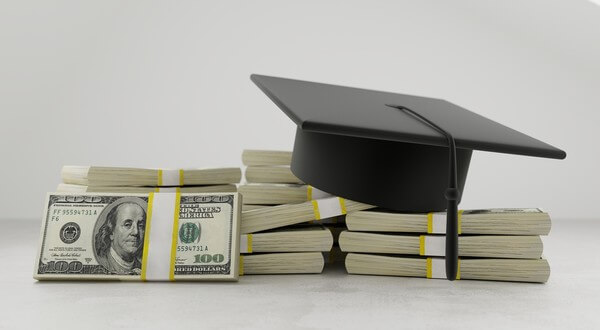What's the Difference Between Subsidized and Unsubsidized Loans?

The difference between subsidized and unsubsidized student loans depends mainly on who pays the interest on the loans during the in-school and grace periods.
The federal government pays the interest on subsidized loans while the student is enrolled in college at least half-time, during the grace period before repayment begins, and during periods of authorized deferment. If the student drops below half-time enrollment or graduates, repayment will begin at the end of the grace period. Authorized deferments include the economic hardship deferment, which is available for up to 3 years in total duration.
The borrower remains responsible for paying the interest on unsubsidized loans. If the borrower defers paying the interest as it accrues during the in-school, grace and deferment periods, the interest is capitalized (added to the loan balance). The borrower is responsible for the interest on both subsidized and unsubsidized loans during a forbearance.
Interest Capitalization
In the federal Direct Loan program, interest is capitalized on unsubsidized loans when the repayment status of the loan changes. For example, interest that accrues during the in-school and grace periods will be capitalized when the loan enters repayment at the end of the grace period.
With private student loans, interest may be capitalized more frequently. With some private student loans, interest may be capitalized as frequently as monthly.
There are certain periods of time when interest is not capitalized on unsubsidized Federal education loans. This includes interest that accumulates during an administrative forbearance or during negative amortization on an income-driven repayment plan.
Impact of Interest Capitalization
Interest capitalization can significantly increase the size of an unsubsidized loan. Typically, interest capitalization will increase the loan balance on a borrower’s unsubsidized loans by as much as a fifth (20 percent) to a quarter (25 percent) by the end of the in-school and grace periods. The actual increase in the loan balance depends on the interest rates, the amount borrowed each year, the duration of the in-school and grace periods, and the frequency of interest capitalization.
For example, if a dependent undergraduate student borrows the maximum unsubsidized Federal Stafford loan amounts during a 4-year college career, a total of $27,000, the loan balance will increase by 15.7 percent by the time the borrower enters repayment. This assumes that the interest is capitalized once, at the end of the grace period. If the loans are capitalized monthly, however, the loan balance will increase by 17 percent.
When borrowers complain about their student loan balance doubling or tripling, it usually involves an extended period of non-payment, usually at least a decade during which the borrower made no or very few payments.
Subsidized and Unsubsidized Loan Programs
There are two main types of subsidized loans, the subsidized Federal Stafford Loan (also known as a Direct Subsidized Loan) and the Federal Perkins Loan. The subsidized Federal Stafford Loan is available to undergraduate students only. The Federal Perkins Loan may be available to both undergraduate and graduate students, depending on the college. The grace period is 6 months on the Federal Stafford Loan and 9 months on the Federal Perkins Loan.
All other loans are unsubsidized. This includes the unsubsidized Federal Stafford Loan (also known as a Direct Unsubsidized Loan), the Federal PLUS Loan (also known as a Direct PLUS Loan), private student loans and private parent loans. The unsubsidized Federal Stafford Loan is available to both undergraduate and graduate students. The Federal Grad PLUS Loan is available to graduate and professional school students. The Federal Parent PLUS Loan is available to parents of dependent undergraduate students.
Impact of Subsidized vs. Unsubsidized Interest
Although subsidized loans are often described as having no interest during the in-school and grace periods, it is better to consider the impact of the subsidized interest benefit on the total payments over the life of the loan.
Generally, a subsidized loan is the equivalent of an unsubsidized loan with an interest rate that is about a third lower, assuming a standard 10-year repayment term. (On a 20-year term, the equivalent interest rate is about a quarter lower. On a 30-year term, the equivalent interest rate is about a fifth lower.) That is like having an interest rate that is 2 to 5 percentage points lower, depending on the interest rate.
For example, suppose a student borrows $19,000 in subsidized Federal Stafford Loans at 6.8 percent interest with a 10-year repayment term, graduating in four years. That’s the equivalent of borrowing unsubsidized Federal Stafford Loans with a 4.4 percent interest rate, assuming that interest capitalizes when the loans enter repayment. Subsidized Federal Stafford Loans can save a borrower thousands of dollars in interest over the life of the loans as compared with unsubsidized loans.
Other Differences Between Subsidized and Unsubsidized Loans
Subsidized loans are usually awarded based on demonstrated financial need. The amount a student can borrow is based on financial need, subject to annual and aggregate loan limits. Unsubsidized loans are available to most students, even wealthy students, and the amounts do not depend on financial need.
The annual and aggregate loan limits for the subsidized Federal Stafford Loan are lower than the overall loan limits for the Federal Stafford Loan. So, all students are eligible to borrow unsubsidized Federal Stafford Loans, even if they are borrowing the maximum amount of subsidized Federal Stafford Loans. For example, the annual loan limits on the subsidized Federal Stafford Loan are $3,500 during the freshman year, $4,500 during the sophomore year, $5,500 during the junior year and $5,500 during the senior year. The annual loan limits on the unsubsidized Federal Stafford Loan are $5,500, $6,500, $7,500 and $7,500, respectively, minus the amount of any subsidized Federal Stafford Loans.
Generally, borrowers should prefer subsidized loans over unsubsidized loans, as the subsidized loans cost less.
When financial aid and federal student loans aren't enough to cover all college costs, consider financing the gap with private student loans. Shop around to find the loans that best fit your needs.